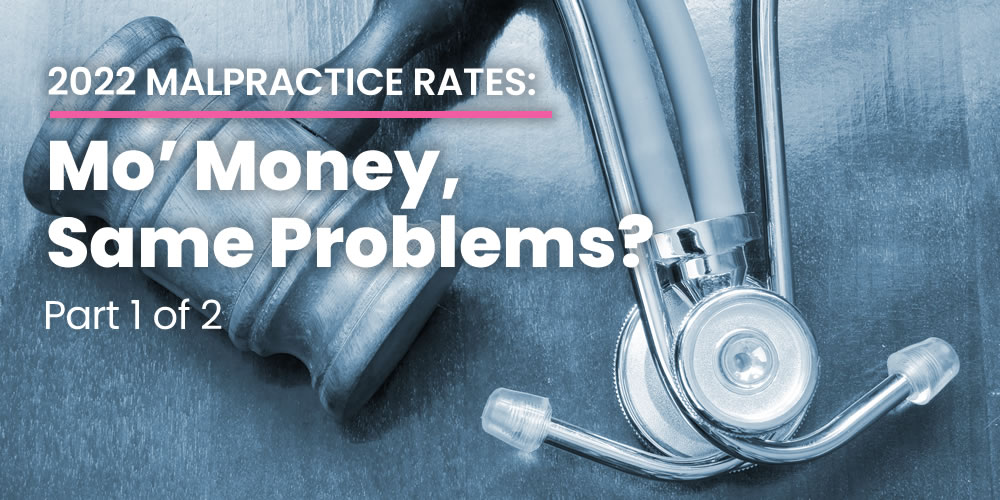The rates are too damn high!
Reminiscent of the party and platform upon which ‘perennial candidate’¹ Jimmy McMillan based his 2010 New York gubernatorial campaign, many stunned locum tenens agency executives today are asking what’s prompting skyrocketing medical malpractice liability insurance rates for locum tenens physicians (or advanced practice providers) in the coming year.
Our research indicates medical malpractice insurance rates actually started rising a few years ago, following a decade or so of stable or even declining rates.²
For example, a February 5, 2019, blog post by US Risk indicated:
“Healthcare costs are rising – for facilities, caregivers, and patients alike. Among the rising costs is that of professional liability insurance, which has increased dramatically due to a sharp uptick in the number of catastrophic liability claims.
“In October 2018, the American Society for Health Care Risk Management (ASHRM)³ produced its annual Hospital and Physician Professional Liability Benchmark report. In the report, typical self-insured liability claims are rising at an annual rate of about two percent, while catastrophic professional liability claims are rising at even high [sic] rates – in some cases, as high as 10%. The ASHRM report looked at numerous factors, comparing data such as demographic, health system type, and region. The projected loss rates in the report for facilities and caregivers are staggering:
- “Projected loss rate for hospital professional liability is just under $3000 per bed for events in 2019, translating to about 1.58 claims per 100 occupied bed equivalents and about $180,000 per claim.
- “Projected loss rate for physician professional liability is about $5500 per physician; frequency is about 3.5 per 100 physicians and about $156,000 per claim.
- “Labor and delivery professional liability claims are especially high, with an average claim of over $400,000. Facility loss rates for obstetrics are projected to be about $180 per birth.”
The post continues, noting the “ongoing problem” of rising professional liability costs for both caregivers and healthcare facilities — sometimes affecting the type, frequency and availability of certain health-related services.
“While the quality of care has improved across the board, providers are still expected to absorb some of the costs associated with liability claims.
“Industry analysts – and hospital staff and managers — are clamoring for liability reforms, such as arbitration agreements and dispute resolution systems. These can help bring professional liability costs to a more reasonable level.”
“Soft Market” Bottomed Out in 2018
Echoing US Risk’s projections and concerns from early 2019, eQuoteMD™, which claims “the largest network of medical malpractice insurance companies in the nation,” while remaining independent, offered a bit more explanation — with a greater sense of urgency — nine months later. In a post titled, “The Cost of Medical Malpractice Insurance is Rising: Be Prepared,” the online brokerage noted:
“Physicians and practice administrators need to prepare for the inevitable increase in medical malpractice insurance premiums at the next renewal. If it doesn’t happen this year, it will happen next year. The medical malpractice insurance market is changing, and premiums are going up.
“Physicians, hospitals, facilities and other healthcare provider groups have enjoyed a little over a decade of steadily decreasing malpractice insurance premiums. The medical malpractice insurance market is cyclical, and mid-way through 2018 it reached the bottom of the “soft market,” making this year the beginning of a new cycle. This new “hard market” may not be as severe as in past decades, but the signs it is coming are prominent:
- Increasing frequency of severe claims;
- Rising rates due to higher loss ratios;
- Fewer discounts available;
- Tighter underwriting guidelines; and
- Smaller, less stable insurance carriers collapsing or being acquired.”
Uncertainty Heightened for Several Reasons
Besides more high-dollar claims, what’s caused medical malpractice insurance costs to increase noticeably over the past couple of years?
In its early-2019 blog post, US Risk highlighted the “changing landscape” of healthcare insurance overall. [The political back-and-forth over ‘the ACA,’ anyone?]
Related to medical professional liability insurance in particular, the “wholesale broker and specialty lines underwriting management firm” pointed to “vigorous mergers & acquisitions activity, leading to a smaller group of insureds and a resultant drop in premiums.”
With a shifting healthcare insurance regulatory⁴ environment, as well, US Risk said we were seeing “an unprecedented level of uncertainty in the insurance marketplace.” And this was before COVID-19 hit in early 2020.
Still, according to eQuoteMD™ two years ago, “The main reason for the change in the medical malpractice insurance market is the increase in the number of large payouts and the severity of those payouts.”
Since then physicians have migrated from many independent, solo or small physician groups to larger groups and hospital [or health system] employment. On July 1, 2021, Becker’s ASC Review reported, “By the end of 2020, almost 70 percent of physicians reported being employed, and there was a steep acceleration of physicians joining hospitals or corporate entities in the last six months of the year.”
eQuoteMD™ noted: “To attract new clients and gain market share in this more competitive environment, malpractice insurance carriers have been reducing rates consistently.
“While they’ve remained profitable for many years, the profits have been minimal for the last 3 years, and many carriers are beginning to see reserves eroding. If combined loss ratios continue above 100 percent, an adjustment will be necessary to keep the carriers solvent. As we’ve mentioned above, this has already started taking place as of late 2019.”
Physicians, HC Staffing Firms Feeling the Pain
According to Medical Economics’ “2021 Physician Report⁵,” malpractice liability and the need for tort reform ranked sixth out of the “Top 8 Issues Facing Physicians in 2020 [a one-point-higher ranking than indicated by physicians responding in 2020 about their 2019 experience].”
However, the survey also indicated that 61% of malpractice insurance premiums stayed the same between 2019 and 2020⁶, while 22% of respondents reported premium increases.
Fast-forward through 2021 (three years after the soft market bottomed out — and toward the end of Y2/COVID-19) and, it appears, ‘the insurance beast must be fed’ — for physician staffing, at least:
In a September 30, 2021, post, Ethos Insurance Partners Co-Founder and Producer David Huss wrote, “Physician staffing was among the first classes of physicians’ med-mal business to begin firming, and so we have already seen significant rate increases with this class of business. Still, I expect an average rate increase of between 10% and 15% over the next twelve months.
“However, there are always aberrations. In this case, specialty and jurisdiction could prompt significant departures from our projection. It’s also important to keep an eye on risks with nursing home/correctional medicine exposures. Mandatory minimum deductibles for risks with even small exposures in these areas are at risk of spiking.
“These days many physician-driven correctional medicine risks are virtually uninsurable. This is especially true for those utilizing a staffing model. As such, it is impossible to provide any credible projection for this class. However, it is worth noting that we are starting to see a small amount of capacity returning to this class of business on a very selective basis. Look for risks where physicians are contracting directly with local/county facilities to lead the way out of this challenging space in the coming years.”
Coming soon in Part 2:
Why is Medical Malpractice Insurance so Expensive?
² In a late 2019 blog post, eQuoteMD™ had already seen “most of the larger carriers push rates up through fewer discounts and filing higher rates in some states. The increases range(d) from 1% to 30% depending on the state, specialty and loss history.”
³ ASHRM is “a professional membership group of the American Hospital Association (AHA) with nearly 6,000 members representing risk management, patient safety, insurance, law, finance and related professions.”
⁴ The states primarily regulate the insurance industry.
⁵ The survey was conducted by HRA®, a full-service healthcare market research agency and a brand of MJH Life Sciences™. Data were collected from physicians who responded to email invitations during the first quarter of 2021.
⁶ Almost a third of respondents (32%) practiced either family medicine (19%) or internal medicine (13%), while an additional 12% practiced pediatrics — for a total 44% of respondents in the “primary care provider” category.
Next, in Part 2, we cover the factors that determine your insurance rate and which doctors are hit hardest by malpractice suits.








